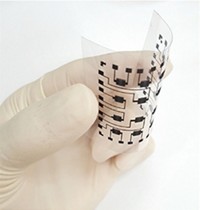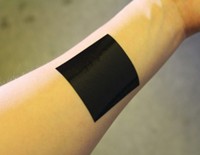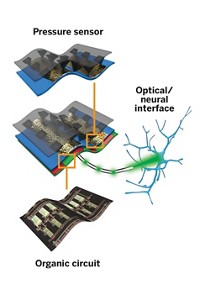Advertisement
Grab your lab coat. Let's get started
Welcome!
Welcome!
Create an account below to get 6 C&EN articles per month, receive newsletters and more - all free.
It seems this is your first time logging in online. Please enter the following information to continue.
As an ACS member you automatically get access to this site. All we need is few more details to create your reading experience.
Not you? Sign in with a different account.
Not you? Sign in with a different account.
ERROR 1
ERROR 1
ERROR 2
ERROR 2
ERROR 2
ERROR 2
ERROR 2
Password and Confirm password must match.
If you have an ACS member number, please enter it here so we can link this account to your membership. (optional)
ERROR 2
ACS values your privacy. By submitting your information, you are gaining access to C&EN and subscribing to our weekly newsletter. We use the information you provide to make your reading experience better, and we will never sell your data to third party members.
Materials
Engineers work to improve that electric feel
Advances in electronic skin could lead to better prosthetics and more independent robots
by Katherine Bourzac, special to C&EN
October 3, 2016
| A version of this story appeared in
Volume 94, Issue 39

Today’s prosthetic hands and other limbs have become incredibly advanced, containing more moving joints and lighter materials than ever before. In some cases, electronic sensors on the prosthetics even read electrical signals from the wearer’s muscles and translate them into movement.
Yet artificial limbs don’t offer the sense of touch that connects us with loved ones or allows us to enjoy the silky feel of a fabric. Perhaps more important, without a sensing skin, today’s prosthetics and robotics lack the ability to pick up on the tactile signals that silently inform our reflexes. A person wearing a prosthetic limb has very little sense of where it is without looking at it.
Researchers working on stretchy, large-area electronics hope to mimic at least some of the critical sensing features of real skin—and add new ones, such as displays that “blush” to communicate emotion. Electronic skin will expand the functionality of prosthetics, allowing the wearer to pick up and feel objects in a more natural way. Sensor skins will also bring new functions to robots, freeing them to move around in uncontrolled environments without hurting people or themselves and squeeze through tight spots.
This year, electronic skin crossed over from the realm of sci-fi visions to commercial reality. MC10 of Lexington, Mass., debuted two products that use small patches of stretchy electronics for health monitoring applications. These first products, which draw on novel ways of using existing materials, will help establish the market for electronic skin. Meanwhile, researchers working on new materials for electronic skins say their work will enable electronic skin to go much bigger, making it possible to create large-area, stretchy electronics that can be tiled onto or wrapped around robots, prosthetics, cars, and other objects.
Circuit stretch
Electronic skin has a lot to live up to. Not only is human skin an incredible network of sensors, it can also wrinkle, stretch, and heal when cut. Our skin’s 1 to 2 m2 of sensors tell us where our bodies are in space so that we don’t have to watch our feet as we walk or stare at our fingers while we pick up something fragile: Sensations from our skin and muscles give us that information without us having to deliberately concentrate on it.
“We have lots of sensors for measuring force, so it seems like a trivial problem to mimic real skin—but it’s not,” says Douglas Weber, who heads the Hand Proprioception & Touch Interfaces (HAPTIX) program at DARPA, the Defense Advanced Research Projects Agency. “Being able to sense touch in the manner our hands do is very challenging,” Weber says. “Every time we grasp an object, the distribution of forces changes slightly.” Even when we hold an inanimate object such as a cup, the forces are not static—they shift with the downward pull of gravity or in other directions because of our own movements.
Weber’s group is currently nearing the end of the second of five years on the HAPTIX project, which aims to develop a prosthetic hand that moves and provides feeling. The main focus of HAPTIX is an interface that stimulates peripheral nerves in the limbs to generate tactile sensations including texture and pressure. The team’s interface uses nerve “cuffs” made out of a biocompatible, insulating material such as silicone implanted with an array of electrical contacts, usually platinum, that can be used to stimulate the nerve with different patterns.
While Weber works on the problem of how to convey tactile sensations to the nervous system, other researchers are working on electronic skins that can detect them.

Although skin detects a multitude of things, temperature and pressure might be the most important to replicate in electronic skin, says Takao Someya, an electrical engineer at the University of Tokyo. Someya was the first to make a flexible touch and temperature sensor. The project came out of his work building thin-film transistors from organic electronic materials at Bell Labs around the turn of the millennium.
When Someya was establishing his lab in Japan, he realized that organic electronics offer one thing the usual semiconductor used for electronics can’t: large areas. Silicon electronics are typically fashioned on rigid wafers of the material; the largest in wide use today are 300 mm in diameter. On the other hand, organic electronics can be made of many different materials, such as conductive polymers, cyclic molecules such as pentacene, or carbon nanotubes. These materials are more amenable to flexible, large-area electronics because they can be put in solution or suspended in inks, then printed or spin-coated over larger areas on a variety of substrates, including flexible plastic or metal sheets.
In 2003, Someya put these realizations into action. His lab made a flexible, pressure-sensing “skin” on plastic by layering a squishy pressure-sensitive sheet between organic transistors that used pentacene as their semiconductor material. The team made the pressure sensor sheet by mixing conductive graphite into polydimethylsiloxane (PDMS). The Tokyo researchers built this layered device on several different kinds of plastic, including polyimide and polyethylene terephthalate. They wrapped the flexible pressure sensors around a robotic hand to demonstrate the concept.
In the same year, Sigurd Wagner’s lab at Princeton University showed that electronic skin could not only bend but stretch. After attending a 1999 meeting on sensor skin conducted by DARPA and the National Science Foundation, Wagner was trying to figure out how to put the ideas discussed there into action. He didn’t have much luck in making electronic skin until the right postdoc, Stéphanie Lacour, joined the group. “By exploration and surprise, she found that when you put metal on rubber, you can stretch it quite far and it will still be conductive, when usually metal will break,” Wagner says. The group started out working with gold, but this applies to other metals, too. Lacour is now developing neural interfaces at the Swiss Federal Institute of Technology (ETH), Lausanne.
Lacour and Wagner’s stretchy conductor inspired Someya. In 2005, he built pressure sensors and organic transistors on rubber, then punched out the excess material surrounding them, rendering the material more stretchy. Ideas about electronic skin had been bandied around for some time, says John A. Rogers, who worked at Bell Labs at the same time as Someya. “Takao was the first to make a fully conformable skin that would wrap around a robot,” Rogers says.
Epidermal electronics
Rogers, too, picked up on the electronic skin idea. But the University of Illinois, Urbana-Champaign (UIUC), materials scientist decided to go with the proven technology, silicon, even though it’s limited in the area it can cover. Rogers is interested in electronic skin for medical applications that require smaller, tattoolike patches instead of large swaths to wrap prosthetics or robotics. He took silicon, the stuff of high-performance electronics, and figured out how to make it work in flexible and then stretchable formats.
Rogers’s lab developed etching and pick-and-place methods to make devices from ultrathin, flexible films of silicon. His research group fabricates electronic components on a silicon wafer using the conventional methods of the semiconductor industry.
Rogers has developed etching chemistries and methods for releasing these tiny components from a wafer. And he’s made stamps for picking them up and placing them onto another surface. The UIUC materials scientist favors stretchy substrates such as PDMS that move and wrinkle with the silicon “skin.” Circuit elements are connected by serpentine metal wires and can be layered up in stacks.
These devices can’t be made in the huge sheets Someya had in mind. But a few square centimeters’ worth can be stuck onto the skin and other tissues for health monitoring. Rogers calls this concept epidermal electronics. It’s being commercially developed by MC10, which he cofounded.

This January, MC10 introduced the first product based on electronic skin: a stretchy electronic sticker that monitors ultraviolet exposure so that wearers know whether they are adequately protected from sun damage. The My UV Patch is about 100 μm thick and goes on like a temporary tattoo. It uses UV-sensitive dye, a near-field communications chip, and an antenna to connect to a mobile phone. When users bring their smartphones near the patch, it sends a signal that causes the phones to boot the associated app. The wearer can then take a photo of the dye patch, which changes color in a way that correlates with UV exposure. MC10 has shipped 1 million of the sensor stickers to its partner L’Oréal. They cost about 50 cents to make, and most of that cost comes not from the electronics but from the dyes, Rogers says.
The company’s second product, announced in March, is capable of more complex functions. While the My UV Patch is disposable, MC10’s BioStampRC is meant to be reused. It’s bandagelike, about 2 to 3 mm thick. As with many small electronic devices, most of the bulk comes from a rechargeable battery. The adhesive layer is replaceable, so the device’s lifetime is limited only by the battery, says Roozbeh Ghaffari, MC10’s chief technology officer. The BioStampRC contains layers of sensors and silicon-based electronics, including an accelerometer, a gyroscope, and electrodes that can measure heart rate and nerve and muscle activity. It also has an onboard memory chip. Ghaffari says the firm is currently selling these devices to biomedical researchers. Some are using the sensors to monitor how a patient’s gait changes from wearing novel prosthetics, for example.
MC10’s strength is not in inventing new electronic materials, but bringing existing ones together in careful designs, Ghaffari says. Because many of these materials—such as silicon—are not inherently stretchable, MC10 must build its devices carefully. “We spend a lot of time modeling where the mechanical stresses are concentrated” within the layers of each new design to make sure it will hold together, he explains. “Since we’re working with the biological interface, it’s a big time-saver to find materials that have already been tested,” he says. “And there’s nothing like silicon—we don’t need to reinvent the wheel.”
Hurdles ahead
For those who want to make more than small patches of electronic skin, there are a lot of practical challenges remaining in engineering and in manufacturing. “We have to sit down and solve all these issues,” Someya says.
Unlike Rogers’s silicon-based skins, Someya’s organic ones haven’t gone into commercial applications yet. Manufacturers haven’t fully worked out how to print organic transistors on a large scale. But Someya notes that this could change rapidly, as it did for the organic light-emitting diode displays now made at massive scales by Samsung and other companies. He’s still working on realizing the initial idea: that organic electronics could be made over large areas, printed in rolls several meters across. “The prototypes are only about 5 by 5 cm,” Someya says.
Perhaps the biggest remaining challenge for electronic skin research is not in the materials or manufacturing, but the design of complex systems, says Princeton’s Wagner. MC10 and many research labs have demonstrated these on small scale, but researchers have to figure out how to do it over even larger areas. Each touch sensor, each light-emitting diode, must be wired up and connected to some central processor and power source, Someya says. Some of his early progress came from realizing he could adapt circuit designs from the flat-panel display industry.
Wagner says researchers need to start thinking about generalizable designs that can truly be made on square-meter scales. “If you have to make it anew for every application, electronic skin is never going to fly,” he says. The field needs to deal with systems-level design problems on the level computer scientists call architecture, he adds. To that end, he’s collaborating with electrical engineers and circuit designers on a generalized architecture for any sort of electronic skin.
“We split out the generic functions from those that are unique,” he says. Their general architecture includes about six layers of flexible electronics including separate layers with batteries, solar cells, memory banks to hold sensor data, circuits to process it, and so on. These generalized units could be mass-produced in tiles 0.1 m2 in area and 0.5 mm thick. Application-specific combinations of sensors are “the special part,” Wagner says. These would be laminated on top—touch sensors for fingertips, or color-changing displays for the “face” of a friendly robot.
Advertisement
Feeling and healing
Some chemical engineers have set loftier goals than mimicking real skin’s sensing abilities. These folks want to surpass our 2 m2 of sensors.
Zhenan Bao, now a chemical engineer at Stanford University, was in Someya and Rogers’s cohort at Bell Labs and was similarly inspired to work on electronic skin. In 2010, she showed how the sensitivity of touch sensors could be boosted beyond that of human skin. Instead of making smooth rubber films, she patterned them with microscale pillars made from PDMS. When compressed, the PDMS pillars deform more readily than a smooth film. This is part of the reason why the patterned sensors are more sensitive. They can also detect new sensations in more rapid succession, giving them better temporal resolution because the pillars recover their original shape rapidly. These skins are sensitive enough to detect the light touch of an insect landing.
Bao is also working on a self-healing skin. Her lab has demonstrated a ruby-red polymer that can be sliced in two with a razor and then put back together, healing in less than a minute. The polymer is also superstretchy. For example, a 2.5-cm piece can be stretched to 2.5 meters, like a piece of gum that won’t break.
This self-healing material can stretch and withstand strains of 10,000%—much more than real skin. The stretchiness could keep electronic parts made from the material out of the repair shop. Bao is now working on using it as the basis for an intrinsically stretchy transistor. She’s using the backbone of this polymer—a modified network of PDMS—to build materials that retain stretchiness and self-healing abilities but add new electronic properties. Her lab is working on semiconductors to serve as the active area and dielectrics to make insulating layers in transistors for stretchy circuits.
But as Bao’s superstretchy material suggests, there’s no need for chemists to limit their imaginations to what human skin can do. “Skin-inspired structure and function are just the beginning,” says Hyunhyub Ko, a chemical engineer at Ulsan National Institute of Science & Technology. Ko is part of a six-year, multi-institute South Korean project to develop a prosthetic hand that will connect to a brain-computer interface and provide feeling and control. But Ko is also thinking about robotics applications and wearable electronics that will expand human capabilities, not just restore them.
Ko imagines a “superskin” with photodetectors all over it. “You could close your eyes and see or feel what’s going on around you,” he says. A robot might do the same. In his lab, Ko shows off a small prototype of a flexible photodetector that can pick up on light from just about any angle. Ko is working on improving the sensitivity of flexible organic photodetectors by growing zinc oxide nanowires on thin films of patterned silicon. Electronic skin covered in photodetectors could help people navigate in the dark, or act as a proximity sensor, enabling a robot or a self-driving car to stop before it runs into something.
When real prosthetics can be outfitted with the kind of sensor sheets Ko, Someya, and others imagine, simple tasks such as cooking an omelette or packing a bag will get much easier for people who rely on them. They’ll also lead to new kinds of safer, more sophisticated robots. And anyone will be able to augment their own natural sensor skin with wearable health monitors and high-tech fashion gadgets that will make it more fun to be a cyborg.





Join the conversation
Contact the reporter
Submit a Letter to the Editor for publication
Engage with us on Twitter